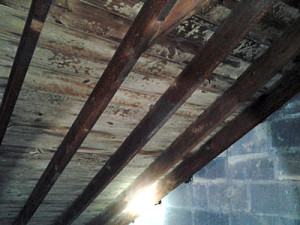Often warning signs of mold are as plain as the nose on your face.
Home sellers know the history of the home and if water leaks have occurred in the past, or even those trouble areas home inspectors find on a home inspection. In a perfect world the seller would always fill out a disclosure that listed all past issues.
But this is not a perfect world and it pays to have a professional inspect not only the home but to collect air and surface samples to determine what types of mold are present in the home you are about to purchase.

Mold in poorly ventilated attic
Here is a short list of items to look for when choosing a home.
- moisture intrusion,
- water damage,
- musty odors,
- apparent mold growth, or
- conditions conducive to mold growth
The home inspector may find evidence on moisture intrusion from a variety of areas such as the roof, gutters, chimneys or vent flashings. Leaks may occur from other sources the home inspector will point out in a report.
Often clients will perform a mold inspection during the home inspection.
You get the benefit of each inspectors experience and convenience of asking questions of both inspectors while at the property. Samples can be collected and sent to the lab. Results are usually available in a few days.
photo courtesy of www.settlershomeinspections.com